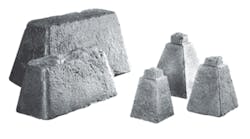With the development of the SMW insert™, ASK CHEMICALS METALLURGY GmbH has arrived at an inoculant that succeeds in giving foundries a decisive procedural advantage in the production and development of better quality ductile iron castings with thicker walls.
The production of high-stress cast parts made from cast iron with nodular graphite is a particular challenge for foundries because of the high demands placed on the inoculation technique used and the inoculants. Using pure charge materials in the burden is essential for successful cast part production. The pig iron used, the scrap steel, or returns may not contain any disruptive impurities.
Thus, there are several important preliminary steps to prevent graphite degeneration (e.g., chunky graphite): Check for harmful trace elements in the base materials, magnesium treatment agents and inoculants, and coordinate with regard to the chemical compositions.
ASK Chemicals Metallurgy’s SMW Insert mold inoculant excels in this connection. The mold inoculation with the cerium- and bismuth-based SMW insert prevents chunky graphite by neutralizing disruptive elements.
A further advantage is that the inoculation process takes place without oxygen. Thus, oxide and sulfide formations, as well as oxidic impurities (e.g., slag) are minimized. The graphite degeneration is prevented due to the very late inoculation of the iron. This process ensures an optimal, uniform inoculation of the entire cast part during mold filling. The nodule count can be increased up to 400 nodules per mm2 and the nodule size reduced.
The mechanical properties, e.g. strength and toughness, are optimized depending on the wall thickness. Additional procedural advantages of the mold inoculant SMW insert are due to the ability to precisely calculate the required dose. The use of an additional metal stream inoculation device can thus be dispensed with.
Use of SMW Inserts— The SMW Insert can be used depending on the trace element content. The recommended amount to be added is in the region of up to 0.2%. The developer also recommends using the inserts in combination with the Germalloy™ mold inoculant, where the influence of trace elements is lower. For example, depending on the trace element content as well as for component-based reasons, the ratio can be 0.10% SMW insert and 0.10% Germalloy™ for an inoculant addition of 0.20%. All previously known P inserts, P 300 to P 30, also available as SMW Inserts.
The SMW Inserts can be used in combination with a preconditioning agent, e.g. VL (Ce) 2 and with a cerium-free and/or low-content-cerium FeSiMg master alloy, e.g. VL 63 O or VL 63 M 3. Small mold inoculation bodies should, in all cases, be installed in the pouring basin as "starters" – e.g. P 300, P 500 and/or P 800 – in order to ensure efficient and prompt inoculation. This will ensure that the cast iron that flows in first – which can solidify near the risers – does not have any chunky graphite and the inoculation effect is realized right from the start of the mold filling.
In addition to the quality aspects, there are also economic reasons for using these mold inoculants according to Dr. Sven Uebrick, Global Product Manager ASK Chemicals Metallurgy. These effects have been tested extensively by ASK Chemicals Metallurgy GmbH and verified in practice.
Visit www.ask-chemicals.com









